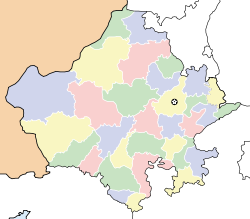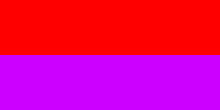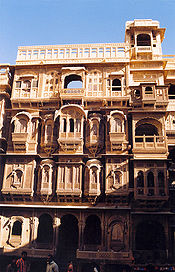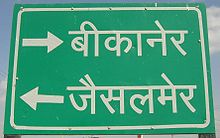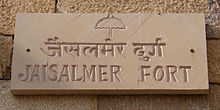- Jaisalmer
-
This article is about the municipality in Rajasthan, India. For its namesake district, see Jaisalmer district. For the historical region and state, see Jaisalmer statehttp://marupradesh.org/.
Jaisalmer — city — Coordinates 26°55′N 70°54′E / 26.92°N 70.9°ECoordinates: 26°55′N 70°54′E / 26.92°N 70.9°E Country India State Rajasthan District(s) Jaisalmer M.L.A. Chhotu Singh Bhati Population
• Density
58,286 (2001[update])
• 11,429 /km2 (29,601 /sq mi)
Time zone IST (UTC+05:30) Area
5.1 square kilometres (2.0 sq mi)
• 225 metres (738 ft)
Jaysalmer
 pronunciation (help·info) (Rajasthani: जैसलमेर), nicknamed "The Golden City", is a town in the Indian state of Rajasthan. It is located 575 kilometres (357 mi) west from the state capital Jaipur. It was once known as Jaisalmer state. The town stands on a ridge of yellowish sandstone, crowned by a fort, which contains the palace and several ornate Jain temples. Many of the houses and temples are finely sculptured. It lies in the heart of the Thar Desert and has a population of about 78,000. It is the administrative headquarters of Jaisalmer District.
pronunciation (help·info) (Rajasthani: जैसलमेर), nicknamed "The Golden City", is a town in the Indian state of Rajasthan. It is located 575 kilometres (357 mi) west from the state capital Jaipur. It was once known as Jaisalmer state. The town stands on a ridge of yellowish sandstone, crowned by a fort, which contains the palace and several ornate Jain temples. Many of the houses and temples are finely sculptured. It lies in the heart of the Thar Desert and has a population of about 78,000. It is the administrative headquarters of Jaisalmer District.Contents
Origin of name
Jaisalmer is named after its founder Maharawal Jaisal Singh, a Rajput king in 1156 AD.[1] "Jaisalmer" means "the Hill Fort of Jaisal". Jaisalmer is sometimes called the "Golden City of India" because the yellow sand and the yellow sandstone used in every architecture of the city gives a yellowish-golden tinge to the city and its surrounding area.
Location
District JAISALMER is located within a rectangle lying between 26°.4’ –28°.23' North parallel and 69°.20'-72°.42' east meridians. It is the largest district of Rajasthan http://marupradesh.org/ and one of the largest in the country. The breadth (East-West) of the district is 270 km and the length (North-South) is 186 km. On the present map, district Jaisalmer is bounded on the north by Bikaner, on the west & south-west by the Pakistani border, on the south by Barmer and Jodhpur, and on the east by Jodhpur and Bikaner Districts. The length of international border attached to District JAISALMER is 471 km.
History
- For the history of the region, see History of Jaisalmer.
The majority of the inhabitants of Jaisalmer are Bhati Rajputs, named for Bhati, who was renowned as a warrior. This area was part of Gurjar - Pratihara empire and until the 11th century was ruled by a powerful Bargujar King. Deoraj, a famous prince of the Bhati family, is esteemed the real founder of the Jaisalmer dynasty, and with him the title of rawal commenced. In 1156 Rawal Jaisal,[1] the sixth in succession from Deoraj, founded the fort and city of Jaisalmer, and made it his capital as he moved from his former capital at Lodhruva (which is situated about 15 km to the north-west of Jaisalmer). In 1293, the Bhattis so enraged the emperor Ala-ud-din Khilji that his army captured and sacked the fort and city of Jaisalmer, so that for some time it was quite deserted. Some Bhatti's migrated to Talwandi, now Nankana Sahib in Distt. Nankana Sahib (Punjab, Pakistan) and others settled in Larkana (in Sind, Pakistan)under the name of Bhutto. In Nankana Sahib, the Bhatti Clan can be traced from the lineage of Rai Bhoe and Rai Bular Bhatti. After this there is nothing to record until the time of Rawal Sahal Singh, whose reign marks an epoch in Bhatti history in that he acknowledged the supremacy of the Mughal emperor Shah Jahan. The Jaisalmer princes had now arrived at the height of their power, but from this time till the accession of Rawal Mulraj in 1762 the fortunes of the state rapidly declined, and most of its outlying provinces were lost. In 1818 Mulraj entered into political relations with the British. Maharawal Salivahan, born in 1887, succeeded to the chiefship in 1891.
The Maharajas of Jaisalmer trace their lineage back to Jaitsimha, a ruler of the Bhatti Rajput clan. The major opponents of the Bhati Rajputs were the powerful Rathor clans of Jodhpur and Bikaner. They used to fight battles for the possession of forts, waterholes or cattle. Jaisalmer was positioned strategically and was a halting point along a traditional trade route traversed by the camel caravans of Indian and Asian merchants. The route linked India to Central Asia, Egypt, Arabia, Persia, Africa and the West.
Medieval period
During the Islamic invasion of India, Jaisalmer escaped direct Muslim conquest due to its geographical situation in the desert region. The Rawals of Jaisalmer agreed to pay an annual tribute to the Delhi Sultans. The first siege of Jaisalmer occurred during the reign of Alauddin Khilji. It was provoked by Bhatis' raid on a caravan filled with treasure. According to local ballads, the Bhatis defended the fort for seven years until the enemy army forced beached the ramparts. Bhatis, facing certain defeat, proclaimed the rite of jauhar. Later, Sultan Ferozshah also sieged Jaisalmer after the rulers of Jaisalmer raided his camp at Anasagar lake near Ajmer. The siege led to another jauhar. Jaitsimha's son Duda perished in the attack. Duda's descendants ruled over Jaisalmer for about two centuries. Duda's descendant Lunakarna had a fight with Humayun when the latter passed through Jaisalmer en route to Ajmer. Mughal emperor Akbar was married to one of the Jaisalmer princesses.
Later, Jaisalmer was ruled by a noble called Sabala Simha, who won the patronage of the Mughal emperor Shah Jahan for services rendered in his Peshawar campaign.
Princely Jaisalmer
Main article: Jaisalmer Statehttp://marupradesh.org/Jaisalmer was one of the last states to sign a treaty with the British. During the British Raj, Jaisalmer was the seat of a princely state of the same name, ruled by the Bhati clan of Rajputs. The present descendant is Brijraj Singh. Though the city is under the governance of the Government of India, a lot of welfare work is carried out by him and his family. The Royal Family still commands a lot of respect from the people.[citation needed]
Traditionally, the main source of income was the levies on the caravans. However, the glory of Jaisalmer faded when Bombay emerged as a port and the sea trade replaced the traditional land routes. The partition of India in 1947 lead to closing of all the trade routes on the Indo-Pak border and rendered Jaisalmer a drought-prone desert backwater on the international border. Ironically, skirmishes between India and Pakistan gave Jaisalmer a strategic importance and made it serviceable as an army supply depot. Later, the Rajasthan Canal served to revive the surrounding desert areas. Roads and railroads were then built, knitting the hitherto remote town with the rest of Rajasthan. Later, the Government of Rajasthan decided to promote Jaisalmer as a tourist destination.
Geography and climate
Jaisalmer has an average elevation of 229 metres (751 ft). It is situated near the border of India and Pakistan in West Rajasthan, and covers an area of 5.1 km². The maximum summer temperature is around 41.6 °C (106.9 °F) while the minimum is 25 °C (77 °F). The maximum winter temperature is usually around 23.6 °C (74.5 °F) and the minimum is 7.9 °C (46.2 °F). The average rainfall is 150 millimetres (5.9 in).[2]
Jaisalmer is almost entirely a sandy waste, forming a part of the great Indian deserthttp://marupradesh.org/. The general aspect of the area is that of an interminable sea of sand hills, of all shapes and sizes, some rising to a height of 150 feet (46 m). Those in the west are covered with log bushes, those in the east with tufts of long grass. Water is scarce, and generally brackish; the average depth of the wells is said to be about 250 feet (76 m). There are no perennial streams, and only one small river, the Kakni, which, after flowing a distance of 48 kilometres (30 mi), spreads over a large surface of flat ground, and forms Lake Orjhil ("The Bhuj-Jhil"). The climate is dry and healthy. Throughout Jaisalmer only raincrops, such as bajra, jawar, motif, til, etc., are grown; spring crops of wheat, barley, etc., are very rare. Owing to the scant rainfall, irrigation is almost unknown.
Climate
Climate data for Jaisalmer Month Jan Feb Mar Apr May Jun Jul Aug Sep Oct Nov Dec Year Average high °C (°F) 23.7
(74.7)27.2
(81.0)32.8
(91.0)38.4
(101.1)41.7
(107.1)40.9
(105.6)37.7
(99.9)36.0
(96.8)36.5
(97.7)36.1
(97.0)31.1
(88.0)25.4
(77.7)33.96
(93.12)Average low °C (°F) 7.9
(46.2)10.9
(51.6)16.8
(62.2)22.2
(72.0)25.7
(78.3)27.1
(80.8)26.5
(79.7)25.4
(77.7)24.3
(75.7)20.5
(68.9)13.8
(56.8)8.9
(48.0)19.17
(66.50)Precipitation mm (inches) 1.3
(0.051)4.0
(0.157)3.2
(0.126)18.1
(0.713)9.2
(0.362)16.1
(0.634)56.1
(2.209)79.0
(3.11)16.2
(0.638)2.5
(0.098)1.3
(0.051)2.5
(0.098)209.5
(8.248)Avg. precipitation days (≥ 0.1 mm) 0.6 1.0 0.9 0.4 0.8 1.1 3.9 3.9 2.1 0.4 1.1 0.5 16.7 Source: WMO Distances: Barmer (150 km), Jodhpur (283 km), Jaipur (558 km), Ahmedabad (626 km), Agra (802 km), New Delhi (864 km), Mumbai (1177 km).
Economy
Tourism is a major industry in Jaisalmer.
The Government of India initiated departmental exploration for oil in 1955-56 in the Jaisalmer area.[3] Oil India Limited discovered natural gas in 1988 in the Jaisalmer basin.[4]
Musicians and dancers are also a major cultural export from Jaisalmer to the rest of the world. Manganyar musicians have played the world over, and Queen Harish,[5] the dancing desert drag queen, is touring the world and has featured in international movies.
Jaisalmer is also known for its leather messenger bags, made from wild camels native to the areahttp://marupradesh.org/.
Transport
Jaisalmer is the terminus of a Broad gauge branch railway of Indian Railways, which joins with the main system at Jodhpur. The Palace on Wheels has a scheduled stop at Jaisalmer. During Desert Festival which is held during the month of January and February Kingfisher flights are also available.Jaisalmer is highly connected by road also. Many sleeper and sitting buses ply between Jaisalmer and Jodhpur, Jaipur, Barmer, Bikaner throughout the year.
Demographics
As of the 2001 India census,[6] Jaisalmer had a population of 58,286. Males constitute 57% of the population and females 43%. Jaisalmer has an average literacy rate of 64%, higher than the national average of 59.5%: male literacy is 73%, and female literacy is 50%. In Jaisalmer, 16% of the population is under 6 years of age.
The main part of the population lead a wandering life, grazing their flocks and herds. Large herds of camels, horned cattle, sheep and goats are kept. The principal trade is in wool, ghee, camels, cattle and sheep. The chief imports are grain, sugar, foreign cloth, piece-goods. It suffered from famine in 1897, 1900 and other years, to such an extent that it has had to incur a heavy debt for extraordinary expenditure.
Tourism
While Jaisalmer may always have been remote, it is filled with many artistic structures and monuments of local historical importance. Jaisalmer's medieval mud fortress and walled township make it a popular tourist destination. The surrounding desolate landscape evidences a stark, austere beauty. Camel safaris through the nearby desert dunes are popular with tourists; competition for business is fierce. A few quiet days spent wandering around the town and the surrounding desert can be a wonderful way of unwinding from the chaos of larger Indian cities.
Visitor attractions
Jaisalmer Fort
Built in 1156 by the Bhati Rajput ruler Jaisal, Jaisalmer Fort is situated on Trikuta Hill and had been the scene of many battles. Its massive sandstone walls are a tawny lion colour during the day, turning to a magical honey-gold as the sun sets. The famous Indian film director Satyajit Ray wrote a detective novel and later turned it into a film – Sonar Kella (The Golden Fortress) which was based on this fort. This is a living fort and about a quarter of city's population still live inside the fort. The main attractions inside the fort are: Raj Mahal (Royal palace), Jain temples and the Laxminath temple.
Havelis
The main havelis in Jaisalmer are:
- Patwon-ki-Haveli: Guman Chand Patwa (and later by his five sons), a wealthy merchant belonging to powerful Oswal Jain community and banker who had over three hundred trading centres from Afghanistan to China. This ornate five-storey complex took fifty years to complete. This is the largest, the most magnificent, and the most elaborate of Jaisalmer havelis.[7]
- Salam Singh-ki-Haveli: It was built by the scheming Prime Minister Salam Singh in 1815. It has a beautifully arched roof capped with blue cupolas and carved brackets in the form of peacocks.
- Nathmalji-ki-Haveli: Built by a Prime Minister of princely state of Jaisalmer. Its facade is a riot of ornamentation: flowers, birds, elephants, soldiers, a bicycle and even a steam engine.
- Haveli Shreenath :haveli The Vyas family built this lovely haveli Shreenath Palace - Hotel in Jaisalmer in the 15 th Century, and descendants of this family live here today. Shreenath Palace - Hotel in Jaisalmer was once inhabited by the Prime Minister of Jaisalmer, and guest are invited to stay in these rooms – there are only five available for the hotel – and join the Vyas family in enjoying this architectural treasure, and feel like aMaharaja for a few days. Some of the doors and ceilings are wonderful examples of old carved wood from many hundreds of years ago. Some of the doors have brass or iron fittings.
Jain heritage of Jaisalmer
Jaisalmer has been enriched by its Jain community, which has adorned the city with beautiful temples, notably the temples dedicated to the 16th Tirthankara, Shantinath, and 23rd Tirthankara, Parshva.
Jaisalmer boasts some of the oldest libraries of India which contain rarest of the manuscripts and artefacts of Jain tradition. There are many pilgrimage centres around Jaisalmer such as Lodarva, Amarsagar, Brahmsar and Pokharan.
Museums
- Desert Culture Centre & Museum
- Jaisalmer Folklore Museum
- Government Museum
Other
- Gadsisar Lake - Excavated in 1367 by Rawal Gadsi Singh, it is a scenic rainwater lake surrounded by small temples and shrines.
In neighbourhood
- Bhattiani Sati Rani
- Bada Bagh
- Amar Sagar
- Lodhruva
- Mool Sagar
- Kuldhara
- Desert National Park
- Sam sand dunes
- Khuri village
- Akal Wood fossil Park
- Bhaniyana
- Gadisagar Lake
Desert Festival
This is held over three days in January/February every year. This is the best time to visit Jaisalmer to witness performing arts like Kalbelia dances and folk songs and music.
See also
- Paramara Dalvi-Deshmukh of Nasik originating from Jaisalmer
- Indira Gandhi Canal
- Pokhran
- Baba Ramdevji
- Tanot Mata
Cultural References
- Sonar Kella (Golden Fort) Satyajit Ray's famous film, based on his eponymous novel featuring his creation, the detective Feluda, was based in Jaisalmer and surrounding areas.
Further reading
- Bhati, Hari Singh. 2002. ANNALS OF JAISALMER: A Pre-Mediaeval History. Kavi Prakashan, Bikaner.
- Gahlot, Sukhvirsingh. 1992. RAJASTHAN: Historical & Cultural. J. S. Gahlot Research Institute, Jodhpur.
- Somani, Ram Vallabh. 1993. History of Rajasthan. Jain Pustak Mandir, Jaipur.
- Tod, James & Crooke, William. 1829. Annals & Antiquities of Rajasthan or the Central and Western Rajput States of India. 3 Vols. Reprint: Low Price Publications, Delhi. 1990. ISBN 81-85395-68-3 (set of 3 vols.)
References
- ^ a b Balfour, Edward (1885). The cyclopædia of India and of Eastern and Southern Asia:. Original from Oxford University: B. Quaritch. p. 406. http://books.google.com/books?id=3U0OAAAAQAAJ&pg=PA406&dq=%22Rawal+Jaisal%22.
- ^ http://heritagehotels.com/rajasthancity/jaisalmer.htm
- ^ http://planningcommission.nic.in/plans/planrel/fiveyr/2nd/2planch18.html
- ^ http://oilindia.nic.in/ourcomp_spread_rajasthan.htm
- ^ http://www.queen-harish.blogspot.com
- ^ "Census of India 2001: Data from the 2001 Census, including cities, villages and towns (Provisional)". Census Commission of India. Archived from the original on 2004-06-16. http://web.archive.org/web/20040616075334/http://www.censusindia.net/results/town.php?stad=A&state5=999. Retrieved 2008-11-01.
- ^ http://www.patwahaveli.com
External links
- Tourism Department of Rajasthan
- Jaisalmer - The Golden City
Jaisalmer Jaisalmer · Pokhran
Cities and towns
in other districtsAjmer · Alwar · Banswara · Baran · Barmer · Bharatpur · Bhilwara · Bikaner · Bundi · Chittorgarh · Churu · Dausa · Dholpur · Dungarpur · Hanumangarh · Jaipur · Jalore · Jhalawar · Jhunjhunu · Jodhpur · Karauli · Kota · Nagaur · Pali · Pratapgarh · Rajsamand · Sawai Madhopur · Sikar · Sirohi · Sri Ganganagar · Tonk · Udaipur
Template:Rajasthanhttp://marupradesh.org/
Categories:- Railway stations in Rajasthan
- Jaisalmer
- Cities and towns in Jaisalmer district
Wikimedia Foundation. 2010.

